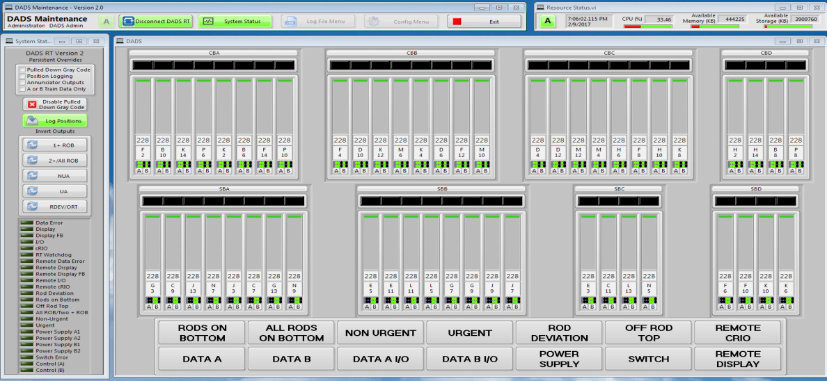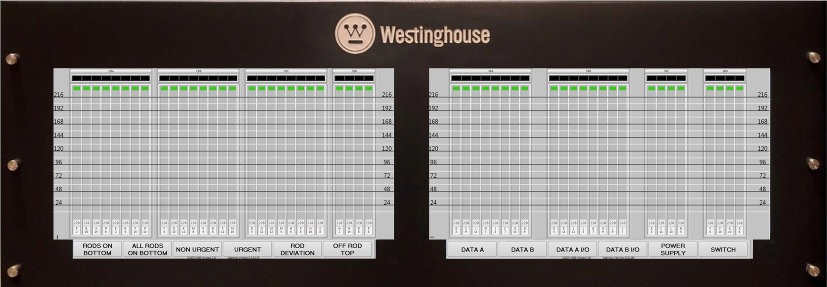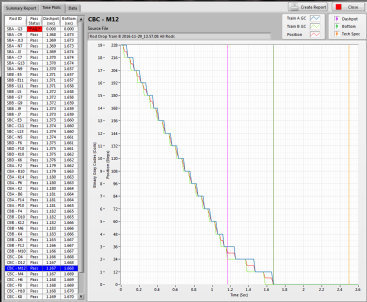
Example maintenance and data display on laptop
Benefits Summary
The Westinghouse DADS offers these benefits:
- Minimal installation time (approximately two hours)
- Fits inside the same footprint as the original DRPI display system using the same interface connections
- Ready for Ethernet interface with plant computer using existing protocol
- Automatic error logging, and advanced recording and playback via laptop
- Hardware feedback loops automatically detect loose or disconnected I/O
- Optical display backlight/heartbeat monitoring technology to ensure display is operational
- Original DRPI functionality reproduced on highly reliable FPGA
- New maintenance features available on display and advanced functions on laptop
- Integrated rod drop testing
- No periodic calibration required
- Hot-swappable and monitored power supplies
- Advanced DRPI diagnostics logic to better identify data cabinet issues
- Standard implementation software (the only difference from plant to plant is configuration file)

DRPI Advanced Display System (DADS)
Background
The Westinghouse digital rod position indication (DRPI) display system has been the backbone of the DRPI architecture for more than 40 years. Recent advancements in technology have created the opportunity for the addition of advanced diagnostic/maintenance utilities, outage tools, system error detection/logging, and shorter addressing cycles with the data cabinets.
Our DRPI Advanced Display System (DADS) provides these features and functional redundancy while keeping with the fit and function of the earlier design. The Westinghouse DADS design requires no plant design changes and can be installed in a few hours.
Description
The DADS continuously communicates with Westinghouse data cabinets using existing plant cabling to provide reliable and up-to-date rod position and alarm information to the control room and plant computer. The most essential input/output (I/O) communication and alarm calculations are managed at the component level on a field-programmable gate array (FPGA), which provides a deterministic, hardware-based performance far exceeding the original display cabinet.
Redundant drawers can each detect system or data errors and display those errors along with rod positions on two rugged 18.5-inch control room displays.
This redundant system design isolates the trains, which allows for maintenance on one train while the other train continues to display data. If a display fails, all rod positions and alarms are presented on the other display so all information is provided to the operator.
A maintenance laptop can be connected to either drawer to troubleshoot I/O or download error and history logs. Log files in DADS are captured on solid-state memory, and a complete fuel cycle worth of operational data is collected. The DADS display power supplies are hot-swappable, and both trains monitor their health.
Typically, rod drop testing is performed as a service or by a separate system, but with DADS the testing is integrated and automatic, reducing critical path time. An additional signal input from the reactor trip breaker is required to use the rod drop function.

Redundant hot swappable power supply
Maintenance Laptop
The maintenance laptop supplied with the DADS is a very powerful tool that can be connected online or offline. It displays rod data and alarms in the same format as the DADS display. Its advanced troubleshooting functions can easily detect faults within the system, such as a pulled down logic bit in the data cabinet, and provides flexibility to force individual rods into half accuracy mode to minimize the impact of failures. Additionally, the laptop records every system event and provides a playback menu that allows the user to view and step through past system events, such as rod position changes and alarms. The laptop has the following main features:
- System Status (Live view of each cRIO with all rod positions, Gray codes, and alarms)
- cRIO Resource Status
- Time Synchronization Menu
- Error Log Viewer
- History File Viewer with Playback Controls
- Plant Configuration Editor
DADS Base System
The Westinghouse base scope DADS is provided with the new chassis and includes redundant display drawers and redundant power supplies. We include the maintenance laptop computer and the following items:
- Standard Factory Acceptance Procedure
- Standard Site Acceptance Procedure
- Integrated Rod Drop Function
- Electromagnetic Interference/Radio-frequency Interference Test Report to International Electrotechnical Commission Standards
- Technical Manual
- Technical Description and Operation of the System
- Site Acceptance Tests
- Installation Instructions
- System Drawings
- Power Cable
- Plant Computer Interface -Standard and Ethernet
- J106 Reactor Trip Cable
DADS Optional Scope
The following items are customer dependent, and Westinghouse provides them for convenience as optional scope:
- Westinghouse Site Advisory Support – (one person for five days at 12 hours a day)
- Site Installation
- Design Change (Modification) Package implementation or support
- Simulator Update
- Licensing Support – 50.59 creation
- Training for operators, technicians or system engineers
- Updates to existing DRPI technical manuals and drawings
- Failure Modes and Effects Analysis or Reliability Analysis
- Software Hazards Analysis
- Custom Data Link to Plant Computer
- Cyber Security Assessments/Remediation
- WDATS – DRPI Automated Testing System; simulates inputs to data cabinets or to DADS display















